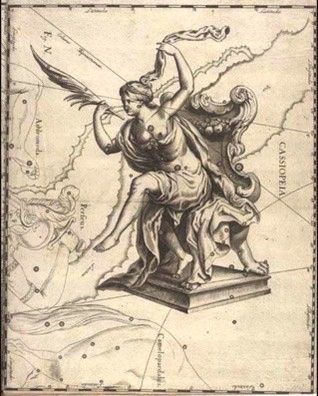Who was Cassiopeia, and Why was she placed in the night sky?
I’m jumping back into the myths! Cassiopeia was my favorite constellation in the sky when I was a child, and I swore to my grandmother at the time that I’d name my daughter after her. Years later, I ditched that idea and decided to write an article instead.

I’m jumping back into the myths! Cassiopeia was my favorite constellation in the sky when I was a child, and I swore to my grandmother at the time that I’d name my daughter after her. Years later, I ditched that idea and decided to write an article instead.
Who was Cassiopeia?
Cassiopeia was a beautiful woman from Greek mythology who became the queen of Aethiopia after marrying King Cepheus. She conceived a daughter with him named Andromeda. Although Cassiopeia and her daughter were considered breathtaking by Greek standards, the queen made sure to flaunt this feature to anyone nearest to her. Little did she know that her vainness would be her downfall.
Which myths mention Cassiopeia the most?
Cassiopeia found her place in Greek mythology alongside gods including Poseidon and heroes including Perseus. The myth starts when Cassiopeia enrages Poseidon because she claimed that she and her daughter were more beautiful than the Nereids. King Nereus, the god of the sea, fathered fifty nymphs who were collectively named the Nereids.
Poseidon held domain over the seas and became offended by the queen’s boastfulness. His anger also stemmed from the fact that his wife is Amphitrite, one of those fifty Nereids. As punishment, Poseidon summoned Cetus, a giant sea monster, to ravage Aethiopia. Panicked, King Cepheus sought counsel from the Oracle. The Oracle told him that he and his wife must sacrifice their daughter, Andromeda, to appease the monster.
Her Harsh Decision
I’m sure that Cassiopeia and her husband would not hesitate in their decision about the monster. They’d pick their daughter and hire a hero to finish off Cetus. Preferably a hero with experience in fighting monsters and saving people. It only seems practical. Unfortunately, Greek mythology doesn’t work like that. The Oracle is the law and is never wrong (Is there proof? probably not.). Traditionally, the king and queen of Aethiopia chained their only daughter and heir to rock as bait for Cetus.
This part of the story is where Perseus comes in. He was a son of Zeus and most known for beheading Medusa the Gorgon. You can also find he alter ego in the absolute hit 2010 action-fantasy movie Percy Jackson and the Lightning Thief (just kidding, read Rick Riordan’s books instead).
Perseus felt renewed after his victory against the Gorgon as he came upon a beautiful woman chained to a rock. Using the freshly severed head of Medusa, he stepped in and rescued Andromeda from Cetus, the sea monster. They eventually fell in love and found the great city of Mycenae.
Her Place in the Night Sky

As punishment, Poseidon placed Cassiopeia and Cepheus in the night sky. Cassiopeia was forever destined to circle the North Pole and spend six months out of the year upside down. This means that one can view the constellation on a clear night at any time and any place. The constellation depicts Cassiopeia sitting in a chain combing her hair to represent her vanity, featuring five bright stars in a zig-zag pattern.
The constellation was first discovered and written down in the 2nd century BCE by Ptolemy, a Greek astronomer. Gamma Cassiopeiae is the brightest star in the constellation, placed in the middle of the five stars. An interesting fact about this star is that its size is comparable to our Sun.
If one can find Polaris, the north star, one can find Cassiopeia. Another recognizable constellation that circles Polaris is Ursa Major, otherwise known as the Big Dipper.